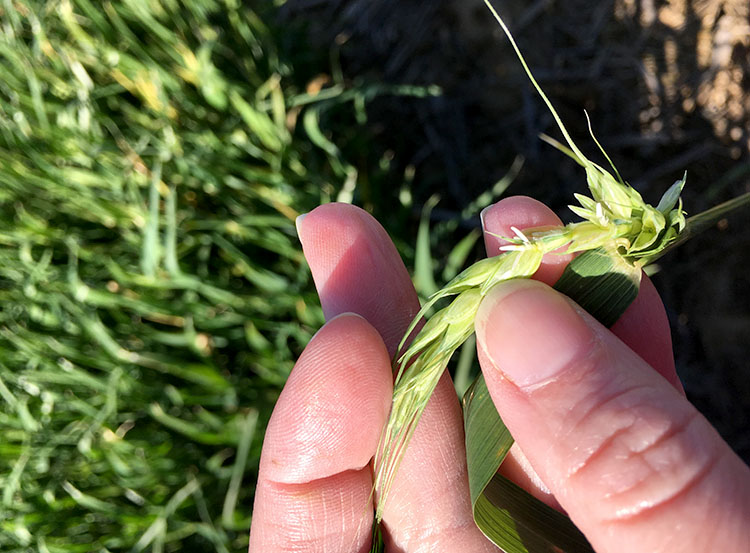Kentucky wheat in advanced growth stages may have significant freeze damage
Kentucky wheat in advanced growth stages may have significant freeze damage

Portions of Kentucky’s wheat crop and other small grains may have significant damage as the result of two nights of freezing temperatures April 15 and 16.
“When I scouted on Monday, April 20, I could see a lot stem damage on wheat that was in the boot (Feekes 10) to early heading (Feekes 10.3),” said Carrie Knott, grain crops specialist based at the University of Kentucky Grain and Forage Center of Excellence in Princeton. “Every stem that I examined at this growth stage was splitting between the second and third nodes from the surface soil.”
The growth stage of wheat determines the low temperatures the crop can withstand. Wheat in earlier growth stages can withstand colder temperatures. Wheat in the jointing stage (Feekes 6-7) can withstand temperatures as low as 24 degrees F for less than two hours. Whereas, wheat in the boot stage (Feekes 10), can only withstand temperature drops as low as 28 degrees F for the same amount of time. If these temperatures drop below these thresholds for an extended time, it can cause moderate-to-severe damage to the crop.
The morning of April 15, nearly the entire state saw temperatures below 30 degrees for at least two hours. For most of the state, it dropped below 28 degrees for several consecutive hours. UK Agricultural Weather Center’s Mesonet station at Princeton recorded six hours below 30 degrees and three hours below 28 degrees, and the station in Lexington charted seven hours below 30 degrees and five hours below 28 degrees.
Freezing temperatures on the morning of April 16 were not as widespread, but several wheat-growing areas experienced those temperatures for consecutive hours on that morning as well. That day, the Mesonet station at Henderson had five hours below 30 degrees and three hours below 28 degrees.
“It’s a little too early to call for wheat that was in Feekes 6-7,” said Knott, who is an associate extension professor in the UK College of Agriculture, Food and Environment. “Every head that I dissected out at those growth stages, the florets were white and the rachis, which are the portion of the head that 'holds' the florets/spikelets, were green. This is not a good sign because it is a signal that the head may be killed.”
Wheat, barley and cereal rye producers should scout their fields for damage for the next couple of weeks to get a better picture of the full extent of the damage and help them decide how to manage the crop going forward.
For wheat that was in advanced growth stages, producers should inspect the wheat for damaged anthers (the male part of the plant) and stigmas (female portion). Knott said much of the wheat that was heading and some of the wheat that was in the boot growth stage have a significant number of dead stigmas and anthers, which would render the plant sterile. For wheat in the boot stage, producers need to dissect the heads to look for damage.
In the wheat she has scouted, Knott said the stigma was not visible, and the anthers were white and appeared deflated. Healthy anthers will be neon green, shiny and almost feel like plastic. Healthy stigmas are white and feel fluffy or feathery.
“Producers will have to decide if there are enough viable flowers to apply a fungicide to protect the plant from Fusarium head blight,” she said. “For some with severely damaged fields, it is not going to make sense to do so.”
In fields that have not yet headed, producers should look for yellow, chlorotic growing points and limp leaves.
“The wheat will likely have yellow tips but as long as the growing point is not affected, there should be minimal to no damage,” Knott said.
They will also want to inspect the stems for damage. If they pull off the outermost leaf, a comprised stem will have yellowing. Stems could also be cracked, brittle or water soaked.
“Comprised stems have an increased risk for lodging now and as the season progresses,” she said. “When the heads start to fill with seeds, they get heavier and will be more prone to lodging where the stems are weakened.”
Extension Research Weather


